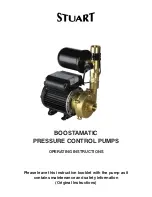
Installation
Wall Mounted Type CNH18/24ADB(AC018/024BNADCH/AA)
‐
If the hole cannot be positioned behind the unit,
find a position as close to the unit as possible. The
piping bundle that exits the unit and extends to the
hole will need to be attached to the wall and will be
visible inside the room.
‐
In relation to the bracket shown above, the unit
is shipped with the drain hose connection on the
right, the drain hose exits the unit on the left, and
the refrigerant pipes are bent to exit on the left.
Thus, positioning the hole to the left requires the
least effort. If you position the hole to the right
or below the unit, you will need to move the drain
hose connection to the left and bend the pipes so
that the hose and pipes exit to the right or bottom.
See the figure in Step 7.
2
Use a standard 2.56 inch(65mm) hole saw to drill one hole
at the selected location, at a 15° downward angle so that
the drain hose will drain properly.
Wall
Drain hose
Indoor unit
3
Based on the hole location, determine where the piping
bundle (drain hose, refrigerant pipes, and cables) will exit
the unit.
<Front view>
<Side view>
Right
bottom
Rear right or left
Left
NOTE
•
The left, right, or bottom exit will only be used if the
hole is not positioned behind the unit.
Connecting the refrigerant pipes
Connect indoor and outdoor units with field-supplied copper
pipes by means of flare connections. Use insulated seamless
refrigeration grade pipe only, (Cu DHP type according to
ISO1337), degreased and deoxidized, suitable for operating
pressures of at least 4200 kPa and for burst pressure of at
least 20700 kPa. Under no circumstances must sanitary type
copper pipe be used.
IMPORTANT
•
When installing the unit, always connect the
refrigerant pipes first, followed by the electrical cables.
For disassembly, always disassemble the electric cables
before the refrigerant pipes.
Two short refrigerant pipes are already attached to the air
conditioner:
•
The smaller-diameter pipe is for the high-pressure,
two-phase refrigerant.
•
The larger-diameter pipe is for the low-pressure
refrigerant vapor.
Refrigerant
pipes
(assembly pipe)
Connection hose
Drain hose
In Step 4 you determined the exit position for the piping
bundle. The unit has three knockouts available for the left,
right, and bottom exits. When the bundle exits directly from
the rear, none of the knockouts are used.
1
If the pipes will exit directly from the rear, skip to step 3.
Otherwise, cut out the appropriate knockout piece (left,
right, or bottom).
2
Use a razor knife to clean the cut edges (flashing).
3
The left exit is the only position that does not require
bending the pipes. For other positions, bend the pipes so
that they will exit in the selected exit position.
‐
The bending radius should be greater than 100 mm.
‐
Bend the smaller pipe gradually to prevent kinking.
The larger pipe has a preinstalled spring bender to
prevent kinking.
‐
Make sure that the pipes do not protrude from the
back of the unit in a way that will make it difficult to
attach the unit to the mounting bracket.
‐
For right and bottom exits, pull the pipes out through
the selected knockout opening. For left exits, the
piping connections will be made in the service space
behind the indoor unit (under the cover panel).
NOTE
•
If you are using the right rear exit, the pipes should
be long enough to extend through the wall without
needing to connect the line set first. It may be easier
to connect the line set outside of the building, after
you have bundled the pipes and cables and passed the
bundle through the wall. In this case, do not connect
the line set now. Instead, complete Step 9 through
Step 12, then go outside and connect the line set as
described below.
4
Slowly remove the protective caps on the refrigerant pipe
connections to relieve the nitrogen holding charge.
5
Connect the line set to each pipe.
Indoor outlet pipe
Connecting pipe
Flare nut
















































